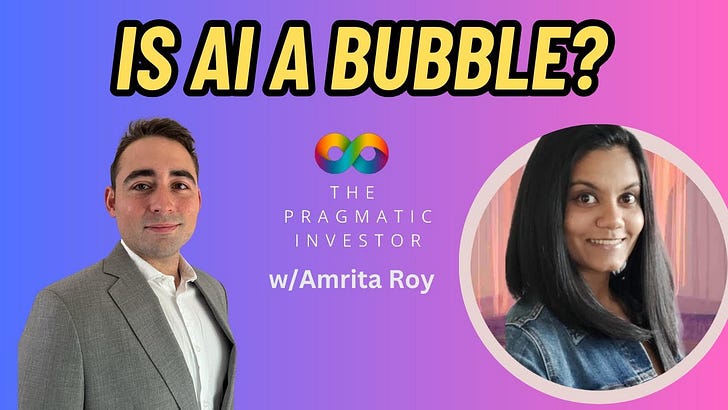Yes, AI is in a bubble. No, it won't pop just yet.
With Nvidia surpassing $2T in market cap, Wall Street is divided. Valuations are extended, & capex is booming. But, what happens when user hype fades & risks come to the forefront?
«The 2-minute version»
It’s been a couple of weeks since one of the most celebrated public companies in technology, Nvidia, crossed $2T in market capitalization. At the same time, such a landmark moment is drawing intense battle lines with speculation that all things AI are in a bubble.
But first, what is a bubble? Put simply, an asset bubble is defined as an upward price movement over an extended range, that eventually implodes. The 1990s dot-com bubble is one such example.
So, are we in one now? Hard to tell, although Torsten Sløk from Apollo Global would point to the current valuations of the top 10 companies in the S&P 500, which now exceed the valuations of the top 10 companies during the tech bubble in the 1990’s.
Aside from valuations, the capex boom is no joke: According to McKinsey, the business investments that the US saw between 1995 and 1999, after the Telecommunications Act was passed, doubled from $250B to $500B . Similarly, the Chips and Science Act passed in 2022 has spearheaded the capex boom in AI as companies increase their capacity so that their machine learning models can run with vast amounts of data and faster.
Are we ready for the trough of disillusionment? According to Gartner’s hype cycle, the expectations of GenAI are in a heightened range. Take a look at the initial adoption of GenAI which has overtaken the initial adoption curves for the smartphone. Not to mention the rage about Sora. But as usage of AI deepens and broadens among the masses, important issues such as plagiarism, deepfakes, cybercrime, racial bias, & privacy are gradually starting to encroach on the AI party. Simultaneously, studies show that Americans are increasingly cautious about the growing role of AI in their lives.
Plus, Apple is awfully quiet in all of this: The iPhone maker is doing the most Apple-esque thing at the moment by staying mum, perhaps buying time to understand how exactly its devices can bridge the usability gap most devices have today between the end user and AI.
It’s been a couple of weeks since one of the most celebrated public companies in technology, Nvidia NVDA 0.00%↑ , crossed $2T in market capitalization. This is a watershed moment for the company which has almost become a beacon of hope for powering the endless possibilities of what AI can do.
For Nvidia, to say that business is booming is an understatement. Such was the demand through last year that many companies & startups (and some countries) began hoarding Nvidia’s semiconductor products. For those living under a rock, Nvidia produces semiconductor chips that accelerate the computing output of computers and servers used to power applications like media, games, cryptocurrency mining, data centers and now, AI.
At the same time such a landmark moment is drawing intense battle lines with speculations that all things AI are in a bubble.
In case you missed, and dove deep into Nvidia in the podcast below to unearth the fundamentals driving the optimism in AI and might the next phase in the innovation cycle look like. 👇🏼👇🏼👇🏼
💭What is a bubble anyway, and why is AI said to be in one?
Right after Nvidia crossed the historic $2T milestone, a corner of the market often identified as bulls cheered the company’s milestone. While Dan Ives, an analyst at Wedbush Securities, sported his Friday best 🥳 and predicted the party was just starting for artificial intelligence stocks, Wall Street’s loudest bull, Fundstrat’s Tom Lee, went further to say that over time the world will replace “salaried workers with silicon.”
On the other hand, Torsten Sløk, chief economist at Apollo Global, published his research note last week, in which he argued that “the top 10 companies in the S&P 500 today are more overvalued than the top 10 companies were during the tech bubble in the mid-1990s.”
All of this debate brings up a fundamental question that is key to understanding whether AI is in a bubble.
➡️But first, what is a bubble really?
In 2015, the US Federal Reserve published a paper that defined an asset bubble as "an upward price movement over an extended range that then implodes." Investopedia defines economic bubbles as “economic cycles that are characterized by the rapid escalation of market value, particularly in the price of assets,” a notion that is similar to the Federal Reserve’s explanation of a bubble. Taking this definition, if we were to simply chart the value of market capitalization of a few top stocks deemed to be beneficiaries of the AI wave, we would quickly observe the rapid escalation in the price of certain stocks, especially Nvidia.
Does that mean we are in a bubble? Well, we wouldn’t know until it implodes. But it would echo Apollo Global economist Torsten Sløk’s concern of high valuation levels, especially when compared to the 1990’s tech bubble as a baseline.
The 90’s dot-com bubble may give us some clues
In order to understand what Sløk was referring to when he pointed to the tech bubble in the mid-90’s, it made sense to look at a few milestones achieved in the 1990’s leading up to the dot-com bubble that eventually burst at the end of that decade.
Here is the entire timeline of all the events leading up to the dotcom bubble that eventually burst in February 2000 followed by the Senate Hearing in 2001 to review the U.S. Telecom Act. The timeline below is exhaustive list of events but it hows how the US Telecom Act was one of the catalysts that began a decades-long boom.






